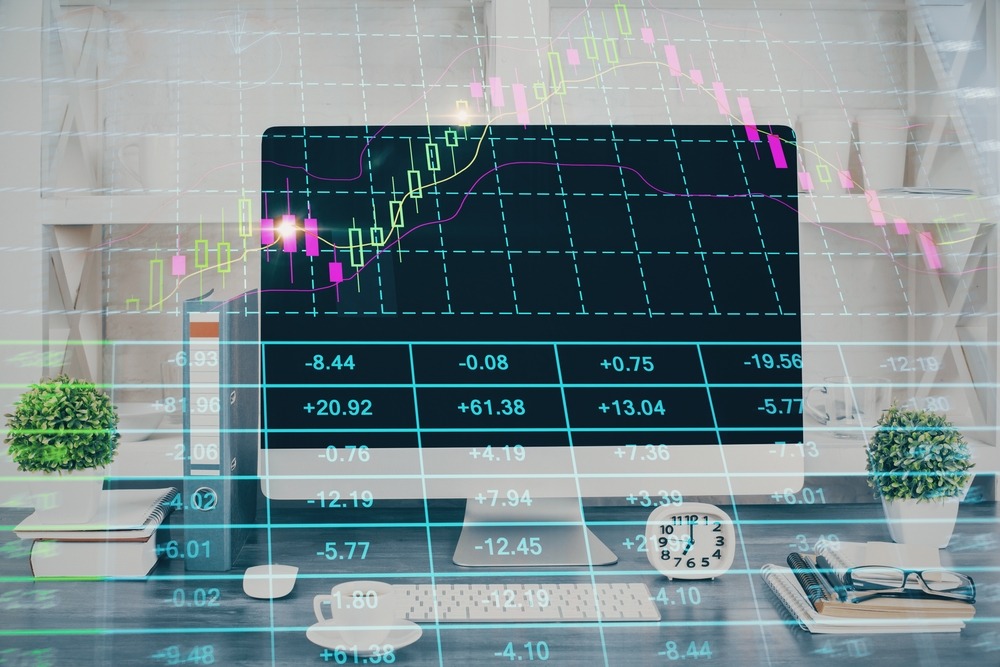Key Points:
- Algorithmic trading uses computer programs to execute trades, enhancing market liquidity and precision.
- Types include statistical trading, auto-hedging, execution strategies, and direct market access.
- Algorithmic trading in forex automates trade orders and identifies arbitrage opportunities.
In the fast-paced world of finance, algorithmic trading has revolutionised how trades are executed, bringing about efficiency and precision previously unattainable through human traders. Coupled with the growth of the forex market, these advancements offer both opportunities and challenges.
In this article we will delve into the intricacies of algorithmic trading, its purpose, principles, and the various types it encompasses. Moreover, we will also explore the burgeoning forex market, highlighting the growth factors, hedging methods, and the significant role algorithmic trading plays within it.
Algorithmic Trading Defined: Speed & Precision

At its core, algorithmic trading involves computer programs executing trades based on predefined instructions or algorithms. This method is designed to generate profits at a speed and frequency that is impossible for a human trader, thereby enhancing market liquidity and introducing systematic precision by eliminating the emotional variability inherent in human decision-making.
1. Speed:
One of the main advantages of algorithmic trading is its ability to execute trades at high speeds. Even milliseconds can make a difference in executing a profitable trade in fast-moving markets. These systems are often co-located with exchange servers to minimise latency, allowing for rapid execution of trades.
High-frequency trading (HFT) is a subset of algorithmic trading, specifically focusing on executing many orders at extremely high speeds, often measured in microseconds or nanoseconds.
2. Precision:
Algorithmic trading algorithms are designed to execute trades precisely according to predefined parameters and rules. These parameters may include price, volume, market trends, and risk management criteria.
Adhering strictly to these rules, algorithmic trading systems aim to minimise human error and emotion, leading to more consistent and disciplined trading decisions.
Additionally, algorithmic trading allows for precise control over order execution, such as splitting large orders into smaller ones to minimise market impact or using advanced order types to optimise trade execution.
The Principles and Types of Algorithmic Trading
Algorithmic trading is grounded in various principles, focusing on timing, price, quantity, and mathematical models to identify and execute trades. This broad approach has given rise to several types of trading strategies, each serving unique functions within the financial markets:
- Statistical trading exploits historical time series data to find profitable trading opportunities through rigorous statistical analysis.
- Auto-hedging strategies create rules that minimise a trader’s exposure to risk.
- Algorithmic execution strategies focus on achieving specific objectives like reducing market impact or executing trades swiftly.
- Direct market access (DMA) ensures optimal speed and cost-efficiency by facilitating direct connections to various trading platforms.
High-Frequency Trading

A notable subset of algorithmic trading is high-frequency trading (HFT), characterised by the extremely high speed and volume of trade order executions. This capability allows traders to capitalise on incremental price changes within milliseconds, offering a significant advantage in the forex market. However, the very nature of HFT introduces heightened volatility, presenting both opportunities and risks.
Redefining Forex: The Algorithmic Impact
The forex market has witnessed substantial growth, fueled by advancements such as automation, drastically reducing transaction hours and increasing efficiency, leading to lower costs.
Enhanced speed in quoting market prices and exploiting arbitrage opportunities have also contributed to this expansion. These factors, combined with the introduction of high-frequency and quick data interpretation techniques, have transformed the forex trading landscape.
Hedging Methods in Forex Trading
In the forex market, hedging is a crucial strategy for managing risk. Methods such as spot contracts and currency options allow traders to protect themselves against adverse movements in currency prices. Spot contracts involve the immediate purchase or sale of a currency. In contrast, currency options offer the right, but not the obligation, to buy or sell a currency pair at a specific rate in the future.
The Role of Algorithmic Trading in the Forex Market
Algorithmic trading has found significant application in the forex market, automating trade orders based on predetermined criteria, updating prices of currency pairs on electronic platforms, and identifying arbitrage opportunities with rapid information dissemination. Additionally, automating binary options for hedging has become a prevalent practice, further underscoring the integral role of algorithms in forex trading.
The Advantages of Algorithmic Trading

- Achieving Best Execution: One of the foremost advantages is its ability to secure the best possible prices for trades. By leveraging advanced algorithms, trades are executed at optimal prices, enhancing profitability and efficiency for traders and institutions.
- Instant and Accurate Order Placement: The low latency of algorithmic trading ensures that trade orders are placed instantaneously and with pinpoint accuracy. This rapid execution is crucial in volatile markets, where prices fluctuate significantly in seconds, offering traders a competitive edge.
- Streamlining Costs and Operations: Algorithmic trading is synonymous with reduced transaction costs. Automating the trading process minimises manual intervention, lowering operational expenses and enhancing the scalability of trading activities.
- Comprehensive Market Monitoring: Another significant advantage is the ability to perform simultaneous checks on multiple market conditions. The systems can monitor and analyse vast amounts of real-time data, enabling more informed and timely trading decisions.
- Minimising Human Error: By automating the trading process, algorithmic trading significantly reduces the risk of manual errors. It also negates emotional and psychological factors, often leading to suboptimal trading decisions, ensuring a more disciplined approach to trading.
- Backtesting Capabilities: Algorithmic trading allows for comprehensive backtesting using historical and real-time data, enabling traders to validate their strategies before applying them in live markets. This analytical approach to strategy development is critical for identifying and refining effective trading methods.
The Challenges and Limitations of Algorithmic Trading

- Latency Sensitivity: Despite the advantages, algorithmic trading has its challenges. Latency issues are a critical concern; even minor delays in execution can result in missed opportunities or substantial losses, emphasising the need for high-speed, reliable systems.
- Unpredictable Market Events: Black Swan events represent another significant risk. These unpredictable market disruptions can cause strategies that usually perform well to incur sudden losses, highlighting the importance of robust risk management practices.
- Technological Dependence: The heavy reliance on technology means system failures can lead to significant losses. Maintaining and updating algorithmic trading systems requires constant vigilance and investment to mitigate these risks.
- Regulatory and Cost Considerations: Algorithmic traders must navigate complex regulatory landscapes, which can be time-consuming and costly. Additionally, the high capital costs associated with developing and implementing trading algorithms can be barriers to entry for some participants.
- Time Scales and Participants: Algorithmic trading spans a wide range of time scales, from high-frequency trading, which operates on milliseconds, to mid- and long-term strategies. This versatility makes it appealing to market participants. For instance, mid- to long-term investors, short-term traders, and systematic traders each leverage this system to achieve specific investment goals.
Key Strategies in Algorithmic Trading

1. Diverse Trading Strategies
Algorithmic trading encompasses a variety of strategies, each designed to exploit specific market conditions or inefficiencies. Trend following, arbitrage opportunities, and index fund rebalancing are just a few examples of offering traders multiple pathways to potential profitability.
2. Advanced Mathematical Models
Strategies based on mathematical models, such as delta-neutral trading, provide sophisticated means to hedge positions or capitalise on market movements. Meanwhile, strategies like mean reversion and those targeting the volume-weighted average price (VWAP) focus on the inherent tendencies of markets to revert to average prices or follow volume trends.
3. Execution Strategies
Execution strategies like percentage of volume (POV) and implementation shortfall are designed to minimise market impact and trading costs. These strategies carefully balance the timing and size of trades to achieve optimal execution, highlighting the nuanced approach required in algorithmic trading.
The Essentials of Setting Up Algorithmic Trading
Algorithmic trading, a method where computer programs execute trades based on predefined criteria, requires a blend of technological and financial expertise. At the core, it necessitates knowledge of computer programming, either developed in-house or through commercial software, ensuring the strategy aligns perfectly with the trader’s goals. Connectivity to networks and trading platforms is non-negotiable.
Similarly, access to real-time market data feeds is essential, empowering the algorithm to spot trading opportunities. Before live execution, backtesting against historical market data is critical, providing insights into the strategy’s viability and potential adjustments for optimised performance.
Ethics & Legality in Algorithmic Trading
Concerns often arise about the fairness of algorithmic trading, with some investors arguing it skews the playing field. Despite these contentions, the practice remains entirely legal. It operates within regulated boundaries, underscoring the need for ethical awareness. Consequently, maintaining transparency in algorithmic strategies is crucial to fostering a fair trading environment.
Programming Language Choices
The backbone of any algorithmic trading strategy is its code. C++ is heralded for its high efficiency in handling vast datasets, a critical factor in high-speed trading. However, Python emerges as a formidable alternative, offering simplicity and accessibility for those venturing from finance into programming. Its comprehensive libraries and community support make Python a practical choice for developing and implementing trading algorithms.
The Balance Sheet: Profiting in Algorithmic Trading
The allure of algorithmic trading lies in its systematic approach, eliminating emotional biases and executing trades precisely. This discipline and the ability to process and analyse data rapidly can enhance profitability. Nevertheless, it’s imperative to acknowledge the inherent risks and the significant investment in time and resources required to develop a robust trading system. The journey towards algorithmic trading involves calculated risk, continuous learning, and adaptation.
Conclusion
In summary, this concise overview serves as an introduction to the multifaceted world of algorithmic trading. It underscores the importance of having a solid foundation in technology and market understanding. Additionally, it highlights the necessity of ethical considerations and the meticulous evaluation of risks versus rewards. As the financial markets evolve, so must the strategies of those who navigate them, with algorithmic trading standing as a testament to the innovative intersection of finance and technology.
















